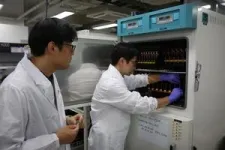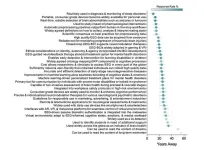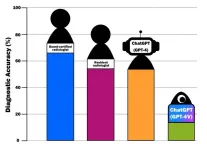(Press-News.org)
Inflammatory bowel diseases (IBD), comprising Crohn’s disease (CD) and ulcerative colitis (UC), are chronic inflammatory conditions affecting the gastrointestinal tract. These diseases can lead to various complications, including strictures, fistulas, and abscesses, significantly impacting patients' quality of life. Endoscopy plays a crucial role in diagnosing IBD, assessing disease activity, and monitoring treatment response. In recent years, advances in operative endoscopy have introduced novel strategies for managing IBD-related complications, particularly strictures and dysplastic lesions. This review summarizes the current endoscopic treatment approaches for IBD, highlighting their advantages and disadvantages.
Inflammatory Bowel Diseases and Their Complications
CD and UC are characterized by inflammation of the gastrointestinal tract, which can lead to irreversible structural damage. CD often presents with strictures, while UC affects gut integrity and increases the risk of colorectal cancer (CRC). Fibrotic strictures in CD and UC pose significant challenges for clinicians and often require surgical intervention. However, modern medical therapies have improved the natural history of IBD, particularly when initiated early.
Endoscopic Treatment Approaches
1. Strictures in IBD
Strictures in IBD are complex and can result from a combination of fibrosis and inflammation. The management of these strictures requires a tailored approach considering factors such as etiology, number, degree, shape, length, location, and associated conditions. Cross-sectional imaging modalities like ultrasound, CT, and MRI are valuable tools for diagnosing strictures and differentiating between fibrotic and inflammatory strictures. Anti-inflammatory medical therapy can reduce wall edema and intestinal wall thickness, while mechanical therapies, including endoscopic balloon dilation (EBD) and surgery, are primarily required for fibrotic strictures.
a. Endoscopic Balloon Dilation (EBD)
EBD is an effective technique for treating CD-related strictures, particularly those localized in the small bowel, ileocolonic, or colonic regions. EBD is best suited for accessible, short, and anastomotic strictures, with through-the-scope balloon catheters preferred due to their safety and ease of use. The dilation process involves inserting a balloon catheter through the stricture and inflating it under X-ray guidance, with the endoscopist determining the appropriate dilation diameter. Retrograde dilation is used for passable strictures, while anterograde dilation with wire-guided balloons is employed for non-passable strictures.
EBD offers short-term symptomatic improvement in the majority of patients, with a significant proportion avoiding surgery for extended periods. However, symptomatic recurrence is common, and the optimal technical details of EBD, such as balloon size and duration of insufflation, remain undefined.
2. Management of Dysplastic Lesions
Dysplastic lesions in IBD patients, which may precede CRC, can be managed endoscopically. Techniques like endoscopic mucosal resection (EMR) and endoscopic submucosal dissection (ESD) offer minimally invasive options for resecting dysplastic tissue. These techniques require expertise and careful patient selection, as they can be technically challenging and associated with complications. Nevertheless, they represent important tools in the management of dysplastic lesions in IBD.
Advantages and Disadvantages of Endoscopic Approaches
Advantages:
Minimally invasive, reducing surgery-related morbidity and mortality.
Preserves bowel anatomy and function.
Repeatable and can be performed as needed.
Can be used to assess disease activity and progression.
Disadvantages:
Technical challenges, particularly with complex strictures and dysplastic lesions.
Risk of complications, including bleeding, perforation, and recurrence.
Limited long-term data on efficacy and durability of endoscopic treatments.
Conclusions
Endoscopic treatment approaches have emerged as important tools in the management of IBD-related strictures and dysplastic lesions. While these techniques offer minimally invasive options, they also require expertise and careful patient selection. Future research is needed to refine technical details, optimize treatment strategies, and improve long-term outcomes. Endoscopic management of IBD should be approached by a multidisciplinary team involving gastroenterologists, radiologists, and colorectal surgeons, ensuring a patient-tailored approach that balances risks and benefits.
Full text
https://www.xiahepublishing.com/2994-8754/JTG-2023-00096
The study was recently published in the Journal of Translational Gastroenterology.
Journal of Translational Gastroenterology (JTG) dedicates to improving clinical diagnosis and treatment, advancing understanding of the molecular mechanisms, and promoting translation from bench to bedside of gastrointestinal, hepatobiliary, and pancreatic diseases. The aim of JTG is to provide a forum for the exchange of ideas and concepts on basic, translational, and clinical aspects of gastroenterology, and promote cross-disciplinary research and collaboration.
Follow us on X: @xiahepublishing
Follow us on LinkedIn: Xia & He Publishing Inc.
END
Parental bed-sharing is unlikely to impact children’s psychological development, new research has found.
The study from the University of Essex looked at nearly 17,000 British babies and tracked them for 11 years – finding kids who shared beds were happy and healthy.
Dr Ayten Bilgin, from the Department of Psychology, found no association between bed-sharing at 9 months and childhood emotional or behavioural problems.
The practice is mired in controversy as some experts previously thought it negatively affected children’s development.
However, others say it helps both parents and children as they are nearby for feeding and if they wake in the night.
Dr Bilgin, said: ...
PULLMAN, Wash. – An artificial intelligence algorithm can allow researchers to more efficiently use 3D printing to manufacture intricate structures.
The Washington State University study, published in the journal Advanced Materials Technologies, could allow for more seamless use of 3D printing for complex designs in everything from artificial organs to flexible electronics and wearable biosensors. As part of the study, the algorithm learned to identify, and then print, the best versions of kidney and prostate organ models, printing out 60 continually improving versions.
“You can optimize the results, saving time, cost and labor,” said Kaiyan Qiu, co-corresponding ...
New research from Northwestern University has systematically proven that a mild zap of electricity can strengthen a marine coastline for generations — greatly reducing the threat of erosion in the face of climate change and rising sea levels.
In the new study, researchers took inspiration from clams, mussels and other shell-dwelling sea life, which use dissolved minerals in seawater to build their shells.
Similarly, the researchers leveraged the same naturally occurring, dissolved minerals to form a natural cement between sea-soaked grains of sand. But, instead of using metabolic energy like mollusks ...
A computational model built by researchers at the Institute of Research in Biomedicine (IRB Barcelona) and the Centre for Genomic Regulation (CRG) can predict which drugs will be most effective in treating diseases caused by mutations that can bring protein synthesis to a halt, resulting in unfinished proteins.
The findings, published today in Nature Genetics, mark an important step in helping personalise treatment by matching patients with specific mutations with the most promising drug candidate. The predictive model, a publicly ...
Researchers from North Carolina State University and Johns Hopkins University have demonstrated a technology capable of a suite of data storage and computing functions – repeatedly storing, retrieving, computing, erasing or rewriting data – that uses DNA rather than conventional electronics. Previous DNA data storage and computing technologies could complete some but not all of these tasks.
“In conventional computing technologies, we take for granted that the ways data are stored and the way data are processed are compatible with each other,” ...
One hundred years after the human brain’s electrical activity was first recorded, experts are celebrating the legacy of its discovery and sharing their predictions and priorities for its future.
Since the first recording in July 1924, human electroencephalography (EEG) has been integral to our understanding of brain function and dysfunction: most significantly in the clinical diagnosis of epilepsy, where the analysis of the EEG signal meant that a condition previously seen as a personality disorder was quickly redefined as a disorder of brain activity.
Now, a century on, more than 500 experts from around the globe, ...
Stroke and spinal cord injuries can severely impair motor functions, and understanding how to promote recovery is a critical challenge. While damaged neurons in the brain and spinal cord have limited ability to regenerate, the brain can form or strengthen alternative neural pathways involving uninjured parts of the brain, enabling functional recovery. Such reorganization of pathways in the brain is called neural plasticity, and identifying the involved pathways and understanding their functions can ...
A study carried out in St Vincent’s University Hospital (SVUH) Dublin challenges the belief that weight loss medications such as Ozempic, Wegovy or Monjaro work just by promoting satiety and making you eat less.
The randomized controlled trial with 30 patients was led by Professor Donal O’Shea, SVUH and UCD School of Medicine, and examined the family of medications based on the hormone Glucagon-like peptide-1 (GLP-1).
The findings published today in the Journal of the Obesity Society shows that there is a strong relationship between the increase in metabolic ...
Inflammation of the abdominal cavity in human fetuses resulting from a perforation of their intestine is likely to be caused by proteins contained in the fetal stool. This is the result of a Kobe University study that establishes a new mouse model allowing research and drug development for a condition that is otherwise difficult to approach.
The fetus’s stool, called the “meconium,” is sterile but nevertheless causes inflammation of the abdominal cavity when it leaks out of the intestine after a perforation. Called “meconium peritonitis,” this is a life-threatening condition for the baby with a mortality rate of 10%-15% in humans, and neither a cause ...
In radiology, diagnostic imaging requires specialized knowledge to interpret the findings associated with a wide variety of diseases. Fortunately, in recent years, generative AI models, such as Chat Generative Pre-trained Transformer (ChatGPT), have shown potential as diagnostic tools in the medical field, but their accuracy must be evaluated for optimal use in the future.
Therefore, Dr. Daisuke Horiuchi and Associate Professor Daiju Ueda of Osaka Metropolitan University’s Graduate School of Medicine led a research team that compared the diagnostic accuracy of ChatGPT and radiologists. They used 106 musculoskeletal radiology cases with patient medical history, images, ...








